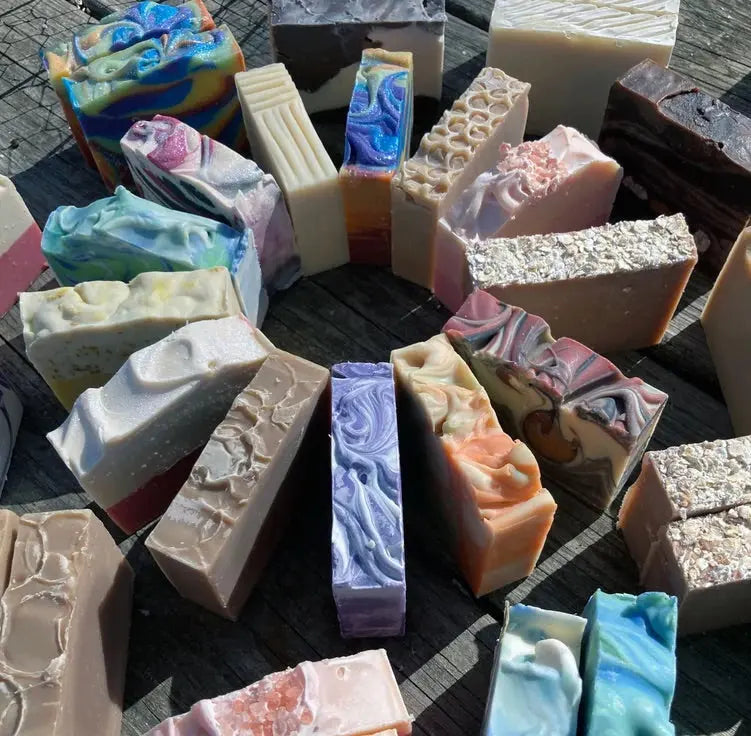Over the years, many of our customers have asked why we choose to make our handmade Goat Milk Soap using the cold process method instead of the hot process method. Both methods are capable of producing a quality, handmade soap. So why do we choose the cold process method over the hot process method? In our experience, the cold process method produces a higher quality soap that lasts longer and is more attractive. Let’s take a look at the differences between the hot and cold process methods and explore why you might choose one over the other if you’re purchasing Goat Milk Soap.
Goat Milk Soapmaking Methods
To make Goat Milk Soap from scratch with the ingredients of your choosing, such as colors, fragrances, or other additives for texture, you can use either the hot process or cold process methods. The main difference between the two is how—and how long—the process of saponification takes place. Saponification is the chemical reaction of the building blocks of fats and oils with the lye to form soap. Essentially, it is the creation of soap from the separate ingredients as they interact.
Cold Process Goat Milk Soap
Cold process soap is made with oils and lye. You combine the lye with the Goat Milk that has been frozen in one container and in another container, combine your oils. When the temperature of each (oils & lye mixture) is within 10-15 degrees of each other, you add the lye mixture to the oils and then combine using an immersion/stick blender to bring the mixture to trace (emulsification with no streaks or oil present). Once your trace is reached, you can add in your fragrances/colors/ additives for texture, combine, and pour the final mixture into your soap mold. In this method, heat is naturally generated through the saponification (soapmaking) reaction while the soap cures in the molds. The soap heats from the inside out.
Hot Process Goat Milk Soap
Similar to the cold process method, the hot process method is also made with oils and a Goat Milk-lye mixture. However, instead of blending until it hits trace (which results in a thicker batter consistency than cold process soapmaking produces) and being poured into a mold, your mixture is heated in a slow cooker. The heat from the slow cooker pushes the soap through the saponification process faster (than the naturally-occurring saponification of the cold process method) and is complete before you put the soap into a mold. The soap heats from the outside in. Fragrance and colorant is added after the soap has cooled (doing so earlier may cause fragrance to dissipate).
Beginners to the soapmaking process should start with the cold process method. The hot process method requires more skill. The addition of heat can scorch your fresh ingredients (like your Goat Milk!) until you get the hang of it. And the heat causes the soap mixture to expand, which can be a messy and precarious situation if you aren’t expecting it.
Differences Between Hot And Cold Process Soap
There are some key differences between the soaps that are made using the cold process versus hot process methods. The process that you use will determine the appearance of your soap, when it will be ready to use, and how long-lasting it is.
Appearance – Cold process soap appears more shiny, polished, and refined. The thinner batter of the soap makes it easier to add swirls of color or embed textured ingredients. Hot process soap has a thick, lumpy batter (making it much harder to add color designs) and the finished soap has a rustic appearance.
Readiness – Hot process soap is ready to use as soon as it hardens but will benefit from a long cure time as well. Cold process soap takes several weeks to cure (we cure ours for five weeks).
Long-Lastingness – Hot process soap can be used as soon as it hardens, but it won’t last as long as cold process soap that has been allowed to cure for several weeks and will soften (or “melt”) faster. Cold process curing allows the remaining water in the soap to evaporate. This creates a harder bar of soap that lasts much longer.
Why We Use The Cold Process Method
So, why do we make Goat Milk Soap using the traditional cold process method, versus the more “advanced” hot process method? It comes down to wanting to provide the very best quality Goat Milk Soap to our customers.
Turnaround time for hot process soap is certainly much quicker, making it easier to keep the shelves fully stocked. However, cold process soap is more durable, the process allows us creative control to make fun, attractive soaps. If you’re using goat milk soap for skin care, this can really make a big difference. We enjoy making soap that is not just great for your skin but also brightens your day a little bit every time you pick it up to wash.
Basic Cold Process Goat Milk Soap Recipe:
- 16 oz Olive Oil
- 16 oz Coconut Oil
- 16 oz Palm Oil
- 3 oz Castor Oil
- 16.5 Frozen Goat Milk
- 7.5 oz Lye


Leave a comment